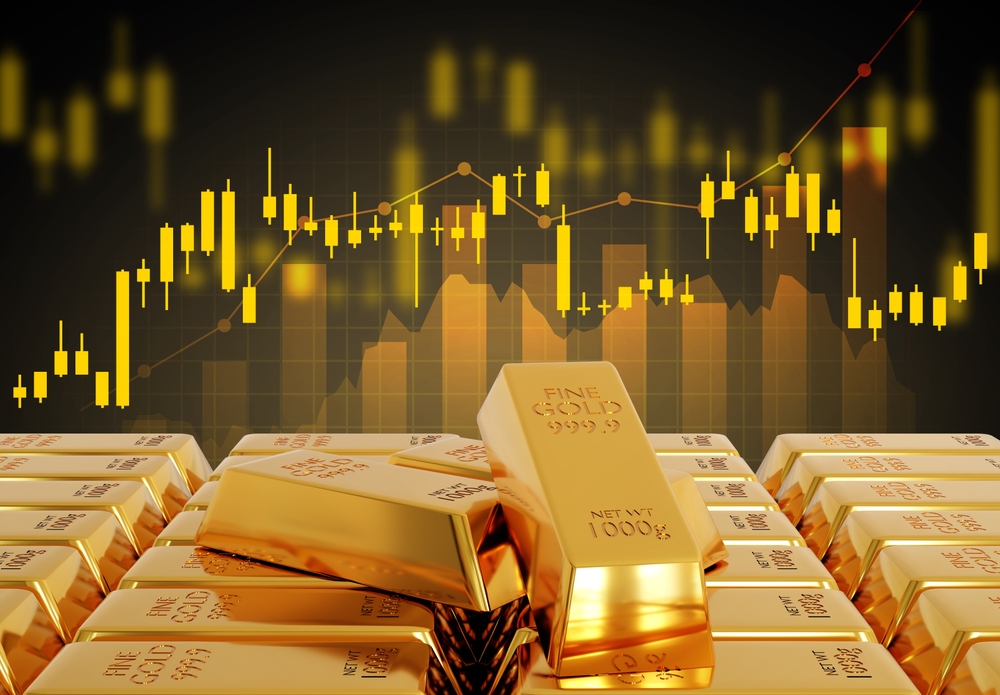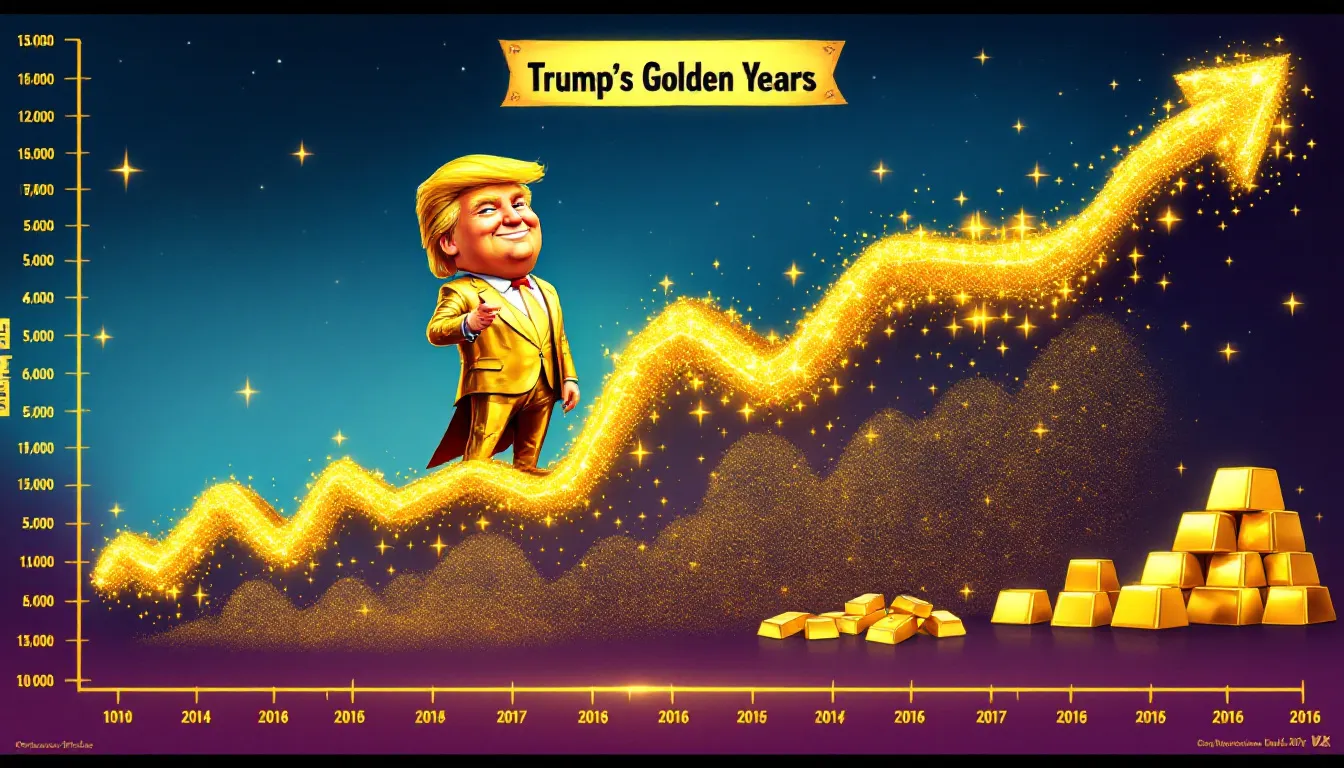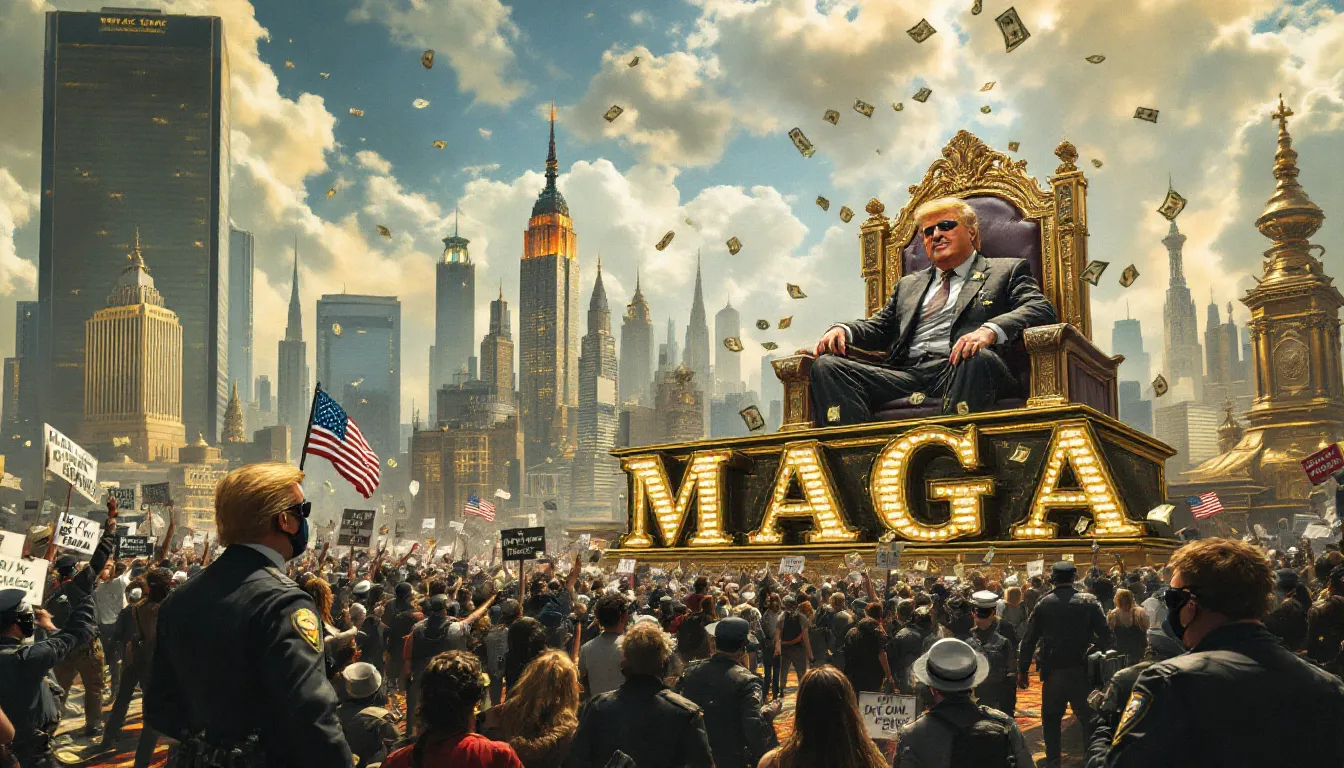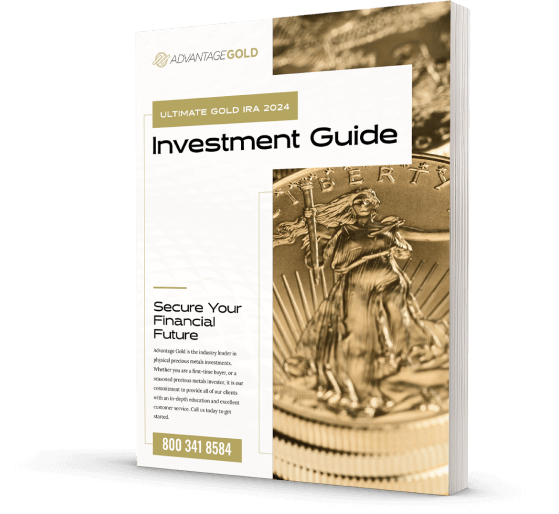
President Trump just won the election. How did Trump’s presidency impact gold prices in the past, and what does that mean for 2025? This article examines the connection between Trump and gold, covering election results, trade wars, and geopolitical tensions. Learn how these factors influenced gold market trends during Trump’s terms.

The night of Donald Trump’s election win in 2016 was nothing short of dramatic for gold prices. As the election results rolled in, gold rates surged by approximately $50, reaching a peak of over $1,300 in early November. This spike was driven by market volatility and investor uncertainty, reflecting the initial shock and reevaluation of economic forecasts under a Trump administration.
Fast forward to the 2020 presidential election, the scenario played out in a similar yet more pronounced manner. In the lead-up to the election, gold traded around $1,900, a testament to the heightened uncertainty. Following Trump’s victory, gold futures saw an immediate rise to $1,951, only to fall below $1,800 in the subsequent weeks. These fluctuations highlighted the market’s reaction to the anticipated economic policies and the rapid shifts in investor sentiment.
Overall, Trump’s election win in both 2016 and 2020 led to significant but brief surges in gold prices, underlining the market’s sensitivity to political events, particularly following trump’s victory during the us presidential election. These moments of volatility were not just reflections of Trump’s unpredictable nature but also indicators of broader economic concerns and expectations.

When Donald Trump took office in January 2017, gold prices were at $1,209. By the time he left the White House in January 2021, they had climbed to $1,839. This significant rise can be attributed to a confluence of economic conditions, trade policies, and geopolitical tensions that characterized his term.
One of the most notable influences on gold prices during the Trump presidency was the series of trade wars, particularly with China. These trade disputes, marked by escalating tariffs and retaliatory measures, led to increased volatility in global markets, prompting investors to turn to gold as a hedge against uncertainty. The precious metal’s performance during these times underscored its role as a safe haven amidst economic turmoil.
Geopolitical tensions also played a crucial role. Conflicts in the Middle East, such as the assassination of Iranian General Qasem Soleimani, triggered spikes in gold prices due to fears of military escalation. These events highlighted how geopolitical instability could drive higher gold prices, reflecting market sentiments about global risks.
Federal Reserve policies during Trump’s presidency further influenced gold prices. The anticipation of rate cuts and monetary easing in response to economic challenges often led to fluctuations in the gold market. Investors closely watched the Fed’s moves, balancing inflation control with growth projections, which in turn affected the price of gold.
In summary, the gold price trends during Trump’s presidency were shaped by a combination of trade policies, geopolitical tensions, and monetary strategies. These factors collectively contributed to the rise in gold prices from $1,209 to $1,839, showcasing the metal’s resilience and its importance as a financial barometer during uncertain times.

Geopolitical tensions were a hallmark of Donald Trump’s presidency, significantly influencing market sentiment and gold prices. The conflicts in the Middle East were particularly impactful. The assassination of Iranian General Qasem Soleimani in early 2020 caused a sharp spike in gold prices, reflecting investor fears of a wider military conflict. This event underscored how quickly geopolitical events could influence gold as a safe haven asset.
Throughout Trump’s administration, tensions with Iran and Israel fluctuated, creating a backdrop of uncertainty that often pushed gold prices upward. Investors, wary of potential escalations, turned to gold to hedge against the risks posed by these conflicts. The yellow metal’s value soared as it became a preferred safety net during these volatile times.
Simultaneously, the U.S.-China trade war was another critical factor. The imposition of tariffs and subsequent retaliatory actions led to significant market volatility. These trade disputes not only affected commodities and currencies but also drove investors towards gold. The precious metal’s allure increased as it provided a refuge from the economic disruptions caused by the escalating trade tensions.
The combined effect of these geopolitical tensions created an environment of heightened uncertainty. Investors, seeking stability amidst the chaos, frequently turned to gold, a precious metal. This trend was a testament to the metal’s enduring appeal as a safe haven during times of geopolitical strife.
In essence, the geopolitical landscape under Trump’s presidency, marked by conflicts in the Middle East and trade wars with China, played a pivotal role in driving gold prices. These tensions underscored the metal’s role as a reliable hedge against global uncertainties.

Central banks around the world also played a significant role in the gold market during Trump’s presidency. Nations like India and China, historically the largest consumers of gold, actively increased their gold reserves. This strategic move was partly driven by ongoing geopolitical tensions, which led these countries to diversify their reserves away from the U.S. dollar towards gold.
The Federal Reserve’s policies during Trump’s term further influenced central bank behaviors. As the us federal reserve navigated the economic challenges with rate cuts and monetary easing, central banks around the globe adjusted their strategies accordingly. The global markets, already volatile due to political and economic uncertainties, saw central banks leaning more towards gold to safeguard their economies against potential crises.
This trend was indicative of a broader shift among central banks to hedge against currency risks and inflation. By increasing their gold reserves, these institutions aimed to bolster economic stability amidst the unpredictability of global markets. The increased central bank purchases of gold underscored the metal’s significance as a cornerstone of financial security.
Investor sentiment towards gold during Trump’s presidency was heavily influenced by the economic and political landscape. The trade wars and international conflicts under Trump’s administration created economic instability, driving investors to seek refuge in gold. The metal’s role as a safe haven asset became more pronounced as market volatility increased.
Trump’s economic policies, including tariffs and sanctions, further fueled investor anxiety. Concerns about inflation and potential economic downturns prompted investors to consider gold as a protective asset. The anticipation of these policies often led to rallies in gold prices as investors hedged against the perceived risks.
The Federal Reserve’s guidance on interest rates also played a critical role in shaping investor behavior. During periods of monetary easing, investors flocked to gold, expecting lower bond yields and a weaker dollar. Conversely, when the outlook for higher Treasury yields grew, gold became less attractive, leading to shifts in market sentiment.
Market optimism, especially following clarity in election outcomes, sometimes diminished the safe haven demand for gold. However, during periods of heightened uncertainty, such as trade conflicts and geopolitical tensions, gold’s appeal surged. This dynamic underscored the metal’s enduring value in the eyes of investors seeking stability amidst market turbulence.
Ultimately, investor sentiment and the demand for gold as a safe haven asset were significantly shaped by the economic policies and geopolitical dynamics of Trump’s presidency. The metal’s ability to provide security in uncertain times reinforced its status as a crucial component of diversified investment portfolios.
In summary, the interplay between Donald Trump’s political journey and gold prices reveals a complex and fascinating narrative. From the immediate market reactions to his election wins to the broader trends during his presidency, gold prices were significantly influenced by economic policies, geopolitical tensions, and investor sentiment. Central banks’ strategic moves further underscored the metal’s role as a cornerstone of financial stability.
As we reflect on the past and consider the future, it’s clear that gold will continue to be a barometer of economic and political uncertainties. Whether or not Trump’s political fortunes and gold prices will rise and fall together in the future remains an open question. However, the patterns observed during his presidency offer valuable insights into the intricate dance between politics and precious metals.
Trump’s 2016 election victory resulted in an immediate increase in gold prices by roughly $50, surpassing $1,300, driven by market volatility and investor uncertainty. This reaction highlights gold’s role as a safe-haven asset during tumultuous political events.
Gold prices during Trump’s presidency were primarily influenced by trade wars, especially with China, geopolitical tensions in the Middle East, and Federal Reserve monetary policies. These factors collectively contributed to fluctuations in investor confidence and demand for gold as a safe haven asset.
Geopolitical tensions during Trump’s presidency, including conflicts in the Middle East and the U.S.-China trade war, significantly drove up gold prices as investors sought refuge in safer assets amid heightened market volatility. Consequently, gold emerged as a preferred investment during these uncertain times.
Central banks, particularly in India and China, significantly increased their gold reserves during Trump’s presidency as a strategy to diversify away from the U.S. dollar in light of geopolitical tensions and economic uncertainties. This trend underscores the evolving dynamics in global financial markets.
Investors turned to gold during Trump’s presidency primarily due to economic instability stemming from his trade policies, inflation concerns, and the Federal Reserve’s monetary easing, viewing gold as a reliable safe haven amidst market volatility.

Please note that Advantage Gold and its representatives are not licensed or registered investment advisers, attorneys, CPA’s or other financial service professionals. We do not offer or render any legal, tax, accounting, investment advice or professional services. Additionally be aware that precious metals carry risk of loss and are not a suitable investment for everyone. Past performance is not necessarily indicative of future results and you should always consult your financial and tax professional and carefully evaluate all risks associated with the acquisition of precious metals before making the investment.
The statements made on this website are opinions of Advantage Gold LLC. Past performance is not necessarily indicative of future results. Precious metals, Gold American Eagles, Proof Gold American Eagles, certified gold coins, as well as gold and silver bars carry risk and investing in precious metals directly or through an IRA is not suitable for all investors. Precious metals and coins (i.e. Canadian Gold Maples, Canadian Silver Maples, American Gold Eagles, American Silver Eagles, Proof Gold American Eagles, Proof Silver American Eagles, Certified Gold American Eagles, Numismatic Gold Coins) may appreciate, depreciate, or stay the same depending on a variety of factors. Precious metals can and will fluctuate unexpectedly. Advantage Gold cannot guarantee, and makes no representation, that any metals purchased (i.e. .999 gold bars, .9999 silver bars, or any gold coins) will appreciate at all or appreciate sufficiently to produce a profit above and beyond the mark up/ commissions charged whether they are bought for direct delivery or inside of a precious metals IRA. The decision to purchase or sell precious metals with cash or inside of a Gold IRA or a Gold Backed IRA, and which precious metals to purchase or sell, are the customer’s decision alone, and purchases and sales should be made subject to the customer’s own research, prudence and judgment. By accessing any Advantage Gold content, you agree to be bound by the terms of service. Review the terms of service and privacy policy.
*Consult your tax Advisor.